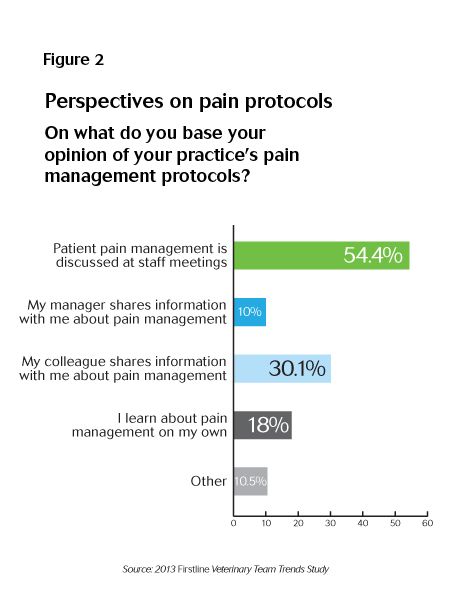Help ease pets' pain
Is your practice up-to-date on the latest pain control protocols? Use these steps to stay in the know.
Next >
Most respondents to the 2013 Firstline Veterinary Team Trends Survey say their practices are up-to-date on the latest pain protocols. But only 18 percent say they learn about protocols on their own time. Most of you are learning about protocols at team meetings.

While you may not make the decisions about your practice's protocols, you can introduce new ideas to get the ball rolling. For example, Ciera Miller, CVT, a Firstline Editorial Advisory Board member and technician at Metzger Animal Hospital in State College, Pa., says when technicians from her practice attend conferences, they share the knowledge by making a list of what they learned and passing it around to all of the team.
"This helps the entire team stay informed of new and upcoming protocols, procedures and medical equipment." Miller says. "It's then up to the veterinarians and practice owner to implement the ideas at their discretion."
For example, she says, many practices are continuing to expand their pain management protocols to make their patients' recovery smoother. "Preoperative procedures, such as epidurals and regional nerve blocks, are being performed to help prevent pain," Miller says. "Constant rate infusions have also become more common during and after surgeries."

Chart your own learning path
There are so many ways available now to get everyone in the practice involved and keep their knowledge current, says Mandy Stevenson, RVT, a Firstline board member and technician at Rolling Meadows Animal Hospital in Adrian, Mo. She offers this short list to get started:
> Read veterinary journals.
> Explore online continuing education. Many companies offer online courses, or you can attend meetings at local specialty practices or community colleges. Some of these are available at no charge or for just a small donation.
> Share what you know at team meetings. Any time there's a new technique or procedure available that can empower your staff members or make things more efficient, it should be brought to everyone's attention.
> Attend seminars. Put together copies of the proceedings and handouts that catch your eye in the exhibit hall and place everything in a folder to give to the veterinarians and practice owners. "Even if everyone didn't go, you can share all of the new ideas and products that might be helpful to the practice," Stevenson says. "This way you're not forcing information on anyone but merely giving them a glimpse of what you learned about."
Podcast CE: A Surgeon’s Perspective on Current Trends for the Management of Osteoarthritis, Part 1
May 17th 2024David L. Dycus, DVM, MS, CCRP, DACVS joins Adam Christman, DVM, MBA, to discuss a proactive approach to the diagnosis of osteoarthritis and the best tools for general practice.
Listen